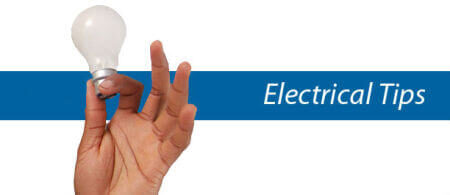
Commercial & Residential Electricians in Mesa AZ.

Commercial & Residential Electricians in Mesa AZ.
As a service to our valued customers in Mesa AZ, Dolce Electric Company is happy to provide you with these electrical tips and tricks. We hope they will help you with some common electrical problems at home. These safe and simple tips for homeowners are ideal for individuals who have a limited knowledge about electrical problems and do not necessarily require an electrician or a service call. You can also contact our in-office electrician in Mesa AZ for free over the telephone help. He might be able to resolve your home electrical problems and save you the cost of a service call.

If the electrical issue you’re dealing with is not addressed in the below list of common problems, give our local electricians in Mesa AZ a call for some free over the phone help. Our in-office Mesa AZ electricians are available Monday thru Friday, between 8:00 AM and 5:00 PM.
Are you interested in a free electrical safety inspection for your home? As part of Dolce Electric Company’s continued commitment to electrical safety at home, our local Mesa electricians offer a free home safety inspection with all repair, installation and troubleshooting service calls. Voted best electrician Mesa AZ, our experts will do the inspection and provide you with your confidential report during your scheduled service. Visit us at free home safety inspections for more information.

GFCI is an abbreviation for ground fault circuit interrupter. Their purpose is to shut off the electricity almost instantly if someone is being electrocuted. Not having GFCI protection increases the possibility of electrocution especially in areas where water is present.
Is this a code violation? Maybe, it depends on the location of the outlet and when your home was built.
Even if your home is grandfathered in Dolce Electric Co strongly recommends upgrading to the current electrical code for the safety of all in your home. For more information and a greater understanding of electrical requirements, visit our page about GFCI Outlets.
How dangerous is this? Very dangerous!
GFCI protection is mandated by the current electric code because it saves lives and prevents injuries. Homes without GFCI protection have a substantially increased possibility of injuries or fatalities caused by electricity. Most home inspectors and real estate agents will insist that these safety devices are installed and working properly before completing the sale of any home.
What’s the solution? Replace the existing outlets with GFCI receptacles or install GFCI circuit breakers as needed.

Not having enough outlets means that your home relies on the excessive use of power strips and extension cords.
Is this a code violation? No, it’s grandfathered in because it was code compliant when it was built. The most recent electrical code mandates a power outlet within 4 feet of the doorway and a minimum of every 12 feet in all living spaces. This is because lamps and other devices come with a 6 foot cord removing the need for an extension cord.
How dangerous is this? It depends.
Overloading any electrical outlet always increases the chances of danger thus fewer outlets increases this possibility. Using light duty 16 and 18 gauge extension cords also increases the danger because they are more prone to overheating. Extension cords run under rugs or across doorways are always a hazard.
What’s the solution? Add additional outlets as needed to remove the use of extension cords.

This indicates that the internal spring tension of the receptacle’s contacts has worn out. Its lack of gripping anything that’s plugged in represents a loose connection.
Is this a code violation? No
How dangerous is this? Very dangerous!
All loose connections produce excessive heat and possible sparking which could start a fire. In many cases an outlet with loose contacts will have visible discoloring on the front from heat.
What’s the solution? Remove the old outlet and replace it with a new one as soon as possible. Be sure to use 20 amp outlets on 20 amp circuits and 15 amp outlets with 15 amp circuits.

All junction, switch and receptacle boxes should be covered. This is where the electrical wires are spliced together or terminated. If one of the splices or terminations becomes undone, accidental electrocution is possible if the wires are touched. A cover protects the wires, keeps out debris and contains any sparking that can be caused by a loose electrical connection.
Is this a code violation? Yes
How dangerous is this? It depends on the location. If the uncovered box is easily accessible the danger is greater.
What’s the solution? Get a new cover and screw it in place. The cost of a cover is minimal considering it may prevent an injury or fire.

Since 1985 all light fixtures specify the maximum allowed light bulb size in wattage. Overlamping means using a light bulb that’s too large for the fixture.
Is this a code violation? Yes
How dangerous is this? Very dangerous!
Traditional incandescent light bulbs convert only about 10% of the electricity used into light. The remaining 90% of electrical power is converted into heat. Using a larger wattage light bulb for additional light also increases the amount of heat produced. This additional unsafe amount of heat can melt or burn the light bulb’s socket and the associated wiring causing short circuiting and sparks that can start a fire. This is especially dangerous when present in surface mounted ceiling fixtures because heat rises damaging everything above the fixture.
What’s the solution? Do not use incandescent light bulbs that exceed the manufacturer’s wattage recommendations. Light fixtures built before 1985 that do not specify wattage size should use a maximum of 60 watts for safety. LED or CFL light bulbs are advisable replacements for reduced heat generation and lowering electrical power usage.
Dolce Electric Co
625 W Southern Ave E239,
Mesa, AZ
85210
Mon – Fri 8:00AM to 5:00PM
Sat – Sun: 8:00AM to 3:00PM